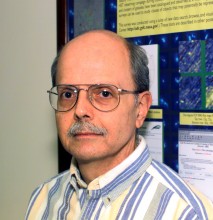 |
 |
 |
 |
 |
 |
 |
 |
 |
 |
 |
 |
|
Alumni
|
Alumni: Richard A. White, 1978 Ph.D., University of Chicago, 1978 June 9, 1946 - May 30, 1999 Webpage He received an AB from the University of California, Berkeley and MS (1971) and PhD (1978) degrees from the University of Chicago. Much of his graduate work was carried out at Yerkes Observatory, under the guidance of W.W. Morgan and Patrick Palmer. One of his hobbies in graduate school was breeding canaries and finches. That these had to be cared for while he was away observing came as a considerable shock to fellow graduate students. One of Richard's scientific passions centered on understanding structure formation in the universe through the study of clusters of galaxies less rich than those in Abell's catalog (≤30 galaxies inside a radius of 2 h75 Mpc). As part of his dissertation, he (together with Morgan, Susan Kayser, and C.E. Albert) compiled the first collection of cD (supergiant) galaxies in poor clusters, identified by visual scanning of Palomar Observatory Sky Survey images. The WP (White-Palomar) catalog of 1977 was among the first such collections of poor clusters, which are far more numerous than richer ones. Their importance in tracing cosmological evolution and large scale structure is only now beginning to be fully appreciated. Richard's early work helped pioneer this aspect of extragalactic astronomy. As a postdoctoral fellow at the National Radio Astronomy Observatory (1977-1980), White collaborated with Jack Burns, Suketu Bhavsar, and Pat Bornmann in creating a new, more extensive catalog of poor clusters of galaxies by applying a computer algorithm (developed by Ed Turner) to Zwicky galaxies. Their definition of poor clusters used a stringent overdensity criterion, later shown to have high reliability and ability to overcome projection effects. White continued to refine this catalog for the next two decades, later in collaboration with Mark Bliton, Mike Ledlow, and Chris Ledlow. |

